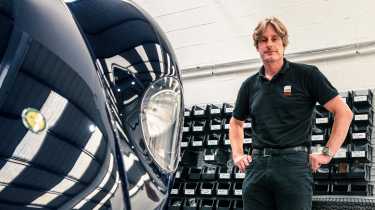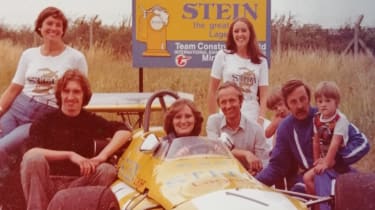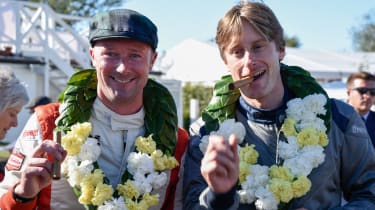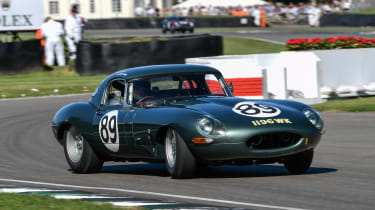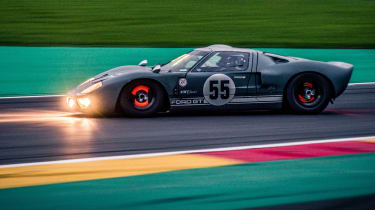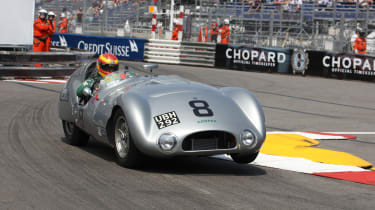My Life & Cars – Chris Ward, Historic racing driver
From a young age Chris Ward was surrounded by the world of motorsport. Here he reveals how he got into racing cars, via motocross, and his love of historics
'One of my earliest memories is one of my dad’s racing cars. A Brabham BT35, at Aintree Circuit. I remember pushing it on the trailer and sitting in it, and also the noise in the paddock. I’d have been about four then.
I’d always seen cars about at home, and I’d always had a little scooter or a little go-kart, or pedal cars. My whole family, including grandparents on both sides, were really into motorsport.
When I was maybe six, Dad got me a little Monkey Bike. I used to ride around the paddock, so when he was out racing, I could go out and watch. That was my first powered vehicle. From that point I was hooked!
> My life in cars – Martin Brundle, Racing driver and F1 commentator
We were coming back from Aintree one day and we saw a grasstrack meeting. So we pulled in and had a look. Dad said, “How do you fancy having a go at that?” I had a go with the Monkey Bike. It was great fun, but I remember almost immediately wanting to do more than go round in circles.
A year or so later my dad bought me a motocross bike. I’d tried a kart by then, too, but preferred two wheels. The first year was just amazing because I had this freedom to learn, but also discovered my competitive side. My dad set the bike up by going out and seeing what was happening. I don’t think my feedback was that great aged seven!
In the second year [1984] we had some support from probably the biggest Honda dealer in the north at that time. Unfortunately two-thirds of the way through the year I broke my leg. It knocked my confidence but I managed to regain it. With the help of Mum, Dad and sponsors I did the British Championship for a number of years. My best were ’87, ’88 and ’89. We won individual rounds, but the best I finished overall was 6th.
I’d moved up to the 125cc class in ’88 and was beginning to understand what Dad was doing with the bike set-up, but as that season ended my dad died. It was a real knock. My mum was amazing as she stepped up, driving our big old converted Snap-on tools van to events all over the country. That first year after Dad had died was my best in terms of performances. I think I was giving it my all to prove we could still do it.
From ’90 onwards I lost a little bit of enthusiasm for it. I was hankering about going track racing on a bike, but when I suggested it to my mum, she was like, “No way! Not at all.” By this time I’d also done a bit with cars, getting opportunities to drive before I was old enough to have a road licence thanks to a family friend called Richard Peacock, who used to own the Aintree Racing Driver’s School.
It was there I first tried a Formula Ford single-seater – a Crosslé 32F. I’d go back a couple of times a year even when I was doing motocross, then eventually started my first year in cars driving a Mondiale Formula Ford. It wasn’t a well-recognised car, but it was well put together. That year was amazing. A real family effort with extra support from Richard [Peacock]. Together we won that year’s Champion of Oulton.
It was never easy to go racing, because we always had to find sponsors, but we did a good job and a I learned so much. Not just race craft, but how to approach people, how to represent myself and my sponsors in the best way I could.
I did a couple of years of FF, then progressed to Formula Vauxhall Lotus in ’95. We did Class B, which meant we weren’t up against big-budget teams like Paul Stewart and Martin Donnelly and Fortec. We raced again in ’96, but money was tight. Fortunately at the end of that year we were approached by a gentleman called Mike Newton, who offered me a drive in his Vauxhall Lotus for the following season. We went on to win Class B.
This was when things started to happen for me, as I’d also met the owner of a British GT race car called the Harrier. This meant I was racing in single-seaters and GTs. We raced the Harrier against some amazing stuff in British GTs – Tim Sugden and Steve O’Rourke’s McLaren F1, Julian Bailey and Tiff Needell in the Lister. The grids were quite something.
By this time I was working as a race school instructor at Oulton Park and Silverstone to earn a living. Loads of guys like me were doing the same, because it was a job you could work around racing commitments. Some days I’d set off at 4am from home near Preston in my MGB and get to Silverstone for 7am. Then I’d do a full day and drive home again.
My mum had owned the MGB from new and I had it from age 17. I did 100,000 miles in it – always with a spare in the boot! I’ve still got it now. I’ve also got a Lotus Europa Twin-Cam. These days my daily driver is an old workhorse E46 BMW 328i Touring, or sometimes my wife’s Golf R, which just does everything so well. I’ve never owned anything exotic because I get my fix in the race cars.
I think it was around 1997 I gained reality and accepted I wasn’t going to make it as a full-time professional driver. That’s why I’d moved into racing GTs, and also historics. Combined with some driver coaching and some manufacturer driving days it just seemed like the best way for me to be able to stay within the sport, be able to enjoy what I was doing, and earn a living out of it.
I became chief instructor at Silverstone in ’99. That was when it was still run by the BRDC. I stayed there until the end of 2001, then I went to Rockingham and helped them set up the circuit. It was an impressive project, but it wasn’t for me because it was like going to a concrete jungle. Fortunately Silverstone hadn’t filled my position, and so I went back a year later, in more of an operational role.
Throughout this time I was still racing various things, including a drive with Nissan as I was involved in running the PlayStation GT Academy at Silverstone. Together with Alex Buncombe and Jordan Tresson we won the 2011 Spa 24 Hours GT4 class.
I left Silverstone in 2014 to join JD Classics as operations manager. It’s a great shame what happened to the business, for at its heart there were some exceptionally talented people. Thanks to their passion JD achieved the highest success in an array of really prestigious events, from Villa d’Este and Pebble Beach concours to race wins at Goodwood, Monaco, Le Mans and Silverstone classic events.
I’m now working with ADP Classic Racing, where I’ve recently joined as operations manager. The business has been running for 18 months or so and is largely comprised of ex-JD specialists. We work really well together and are determined to achieve the same kind of success we enjoyed at JD. It’s an exciting project to be a part of.
I’ve always tried to develop a relationship with each car I race, but especially in historics. They’ve all got their own individual characteristics. The Fangio C-type was a fantastic car to drive because of the history. It was such an agile car, you could pretty much put it wherever you wanted to. And you could drift it without losing time.
The Lister Jaguar is a car that can bite you. You’ve got to respect it big time, but its really exciting to drive. The E-type gave JD its first Goodwood TT success, which was just amazing. To go back the following year and win it again was unreal. We gave the hat-trick a good crack, but it didn’t quite pan out.
I love racing at Goodwood. The atmosphere is so special and the track is unchanged from the old days. It’s a track where mistakes have consequences. You can’t run wide and just keep your foot in. You have to be precise, and that’s what I thrive on.
It’s the same at Monaco. When you’re sitting in a race car with your eyeline below the level of the Armco you can’t look through the corners, so you have to turn instinctively. I’ve raced the C-type and a Cooper there, the latter in an absolute deluge. I cannot tell you how slippery it was around there on historic tyres.
My most memorable race was the 2017 Spa Six Hours in a GT40. There’s so much history at Spa, and so much history attached to the GT40. To win that race was an amazing team effort. We’d been leading the previous year when an oil union fractured and put us out of contention. The following year we applied all the things we’d learned and everything just fell into place. It was an awesome experience. I certainly hope to be doing a lot more of the same over the coming seasons. Obviously this year has been heavily disrupted by Covid, but there’s plenty of racing to round out the year.
We’ve got some fantastic race cars that we look after at ADP, including a Lister, Tojero and a lovely early E-type. While we haven’t been out racing much until very recently the restoration side of the business is doing really well, as it seems people have decided to get major projects done while the calendar for classic races, concours etc has been quiet.
I’m extremely fortunate to do what I do and to have the opportunities to race the things I do. Much of it is down to a whole heap of people that have helped me to be able to get there. Engineers, sponsors, owners. And, of course, my parents. Nothing can beat living your passion.’
